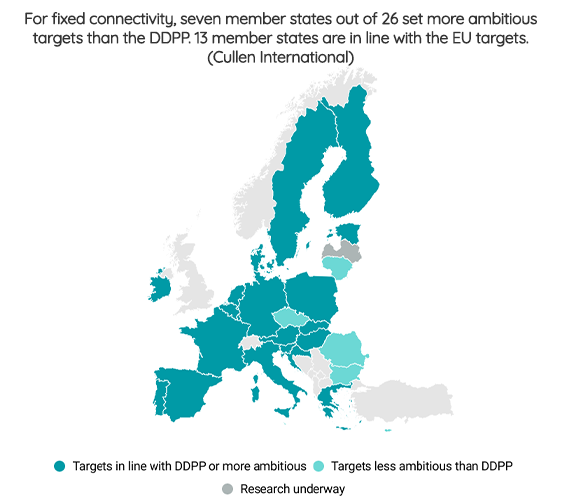EU member states must present their national strategic roadmaps towards reaching the digital decade policy programme (DDPP) targets to the European Commission by 9 October 2023 at the latest.
EU member states must provide Gigabit connectivity for all households and cover all populated areas with 5G or equivalent networks:
The national roadmaps due for 9 October 2023 must specify per target the measures that have been planned, adopted and implemented, along with allocated human resources and public funds. Member states must also estimate the investments further needed as well as the source of such investments.
Many European countries already adopted broadband connectivity targets in line with 2030 EU goals. Some member states are even more ambitious.
Some national plans were adopted years ago for the 2025 goals laid out in the EU Gigabit Society and 5G Action Plans set out in 2016, and may be updated or overtaken in view of the October DDPP deadline.
Cullen International’s benchmark reports the national targets currently set by member states. It also highlights if they are more or less ambitious than the DDPP targets (status 6 September 2023).
Where no national plans were adopted, or if they were referred to the old EU targets (EU 2025 Gigabit Society and 5G Action Plans), the plan is indicated as less ambitious.
For fixed connectivity, seven member states out of 26 set more ambitious targets than the DDPP. 13 member states are in line with the EU targets.

For mobile connectivity, four member states out of 26 set more ambitious targets than the DDPP. Nine member states are in line with the EU targets.
For access to the benchmark, please click on “Access the full content” - or on “Learn more”, in case you are not subscribed to our European Telecoms service.
more news
10 December 25
Recent initiatives to protect copyrighted works from unlicensed use in training AI models in the Americas
Our new benchmark compares new initiatives across the Americas that address the impact of artificial intelligence (AI) training on the creative sector, particularly regarding the use of copyright-protected works.
09 December 25
Initiatives to protect the creative sector from the unlawful exploitation of copyrighted works by AI systems in Europe
Our new European benchmark shows national debates on the impact of artificial intelligence on the creative sector, particularly regarding the use of copyright protected works to train generative AI systems.
01 December 25
Lithuanian regulator plans local regulatory holidays in the wholesale local access market
FREE download for ALL of our latest analysis!